Spatiotemporal Analysis, Predictive Modeling, and Driving Mechanism Investigation of Carbon Storage Dynamics in Changde City Under the Framework of LUCC
Abstract
1. Introduction
2. Materials and Methodology
2.1. Research Region
2.2. Data Support
2.3. Research Methodology and Theory
2.3.1. Spatiotemporal Dynamic Evolution of Land Use
2.3.2. Land Use Prediction Under Multiple Scenarios
- (1)
- Natural Development Scenario: This scenario illustrates the trends in land use changes identified from 2000 to 2020, operating without any additional constraints. The variables associated with neighborhood factors and the transition cost matrix for each type of land use are maintained as constants. Using a historical matrix of land use transition probabilities, the distribution of various land use types in Changde for the year 2030 was predicted through a Markov chain approach, considering the natural development scenario.
- (2)
- Ecological Protection Scenario: The Changde City Territorial Spatial Master Plan (2021–2035) emphasizes the coordinated protection of the mountain, water, forest, farmland, lake, and grassland ecosystems, prioritizing the creation of protective spatial patterns for ecological, agricultural, and disaster prevention purposes. This aims to establish an ecological protection framework characterized by “one core, two corridors, and multiple regions”. To achieve this, modifications are applied to the land use transfer matrix and the parameters for domain weight in accordance with the natural development scenario. In particular, the likelihood of forest and grassland being transformed into construction land is decreased by 50%. Additionally, the ongoing Grain-to-Green Program is continued, increasing the probability of farmland being converted to forest and grassland by 30%. The chance of farmland being transformed into water bodies has risen by 10%, while the probability of transforming unused land into forests and grasslands has risen by 20%. Additionally, there are stringent limitations on the conversion of water bodies to other types of land use. These measures are designed to strengthen ecological barriers, enhance regional ecological resilience, and guide land use changes toward more environmentally sustainable directions.
- (3)
- Arable land Protection Scenario: Changde City, as a major grain-producing region in Hunan Province, ranks first in both the quantity and quality of its farmland. The Master Plan for Territorial Spatial Development proposes optimizing the agricultural industrial layout in a “one core, two belts, and multiple areas” framework. It stresses the need for strict farmland protection to ensure food security, optimize agricultural production, and promote the development of modern agriculture. The scenario presented is designed to enhance the utilization of farmland and safeguard agricultural resources, targeting a significant reduction in the conversion of farmland to construction land by 70%. This initiative also aims to lower the probability of farmland being transformed into grassland and water bodies by 40%. In conjunction with these reductions, there is a strategic increase of 50% in the likelihood that unused land will be repurposed as farmland. These comprehensive measures are specifically intended to effectively advance the integrated protection of farmland—in terms of its quantity, quality, and ecological integrity. As a result, this approach lays a strong resource foundation that is essential for the sustainable development of a modernized New Changde.
2.3.3. Spatial Distribution and Calculation of Carbon Stocks
2.3.4. Analysis of Driving Factors for Carbon Stocks
3. Results and Analyses
3.1. Spatiotemporal Evolution and Prediction of Land Use
3.1.1. Interannual Changes in Land Use from 2000 to 2020
3.1.2. Land Use Predictions for 2030 Under Multiple Scenarios
3.2. Spatiotemporal Distribution Characteristics of Carbon Storage
3.2.1. Spatiotemporal Analysis of Carbon Storage Changes from 2000 to 2020
3.2.2. Analysis of Driving Forces Behind the Spatial Differentiation of Carbon Storage
3.2.3. Prediction and Analysis of Carbon Storage in 2030 Under Multiple Scenarios
4. Discussion
4.1. Characteristics of Carbon Storage Changes and the Impact of Land Use Transformation
4.2. Spatial Distribution of Carbon Storage and Key Influencing Factors
4.3. Limitations of Model Application
5. Conclusions
Author Contributions
Funding
Institutional Review Board Statement
Informed Consent Statement
Data Availability Statement
Acknowledgments
Conflicts of Interest
References
- Li, S.; Zhang, Y.; Wang, Z.; Li, L. Mapping human influence intensity in the Tibetan Plateau for conservation of ecological service functions. Ecosyst. Serv. 2018, 30, 276–286. [Google Scholar] [CrossRef]
- Rodríguez-Echeverry, J.; Echeverría, C.; Oyarzún, C.; Morales, L. Impact of land-use change on biodiversity and ecosystem services in the Chilean temperate forests. Landsc. Ecol. 2018, 33, 439–453. [Google Scholar] [CrossRef]
- Cai, Y.; Wang, L. Carbon sequestration and greenhouse gas mitigation paths and modes in a typical agroecosystem in northern China. Chin. J. Eco-Agric. 2022, 30, 641–650. [Google Scholar]
- Msofe, N.; Sheng, L.; Lyimo, J. Land use change trends and their driving forces in the Kilombero Valley floodplain, southeastern Tanzania. Sustainability 2019, 11, 505. [Google Scholar] [CrossRef]
- Yu, G.; Hao, T.; Zhu, J. Discussion on action strategies of China’s carbon peak and carbon neutrality. Bull. Chin. Acad. Sci. 2022, 37, 423–434. [Google Scholar]
- Liu, Y.; Lü, C.; Fu, B.; Yu, B. Terrestrial ecosystem classification and its spatiotemporal changes in China during the last 20 years. Acta Ecol. Sin. 2021, 41, 3975–3987. [Google Scholar]
- Yang, J.; Xie, B.; Zhang, D. Spatio-temporal evolution of carbon stocks in the Yellow River Basin based on InVEST and CA-Markov models. Chin. J. Eco-Agric. 2021, 29, 1018–1029. [Google Scholar]
- Xu, X.; Liu, J.; Zhuang, D. Remote sensing monitoring methods of land use/cover change on national scale. Anhui Agric. Sci. 2012, 40, 2365–2369. [Google Scholar]
- Chu, P. Research Upon Land Use/Cover and Vegetation Carbon Storage Change at County Scale. Master’s Thesis, China University of Geosciences, Beijing, China, 2014. [Google Scholar]
- Cao, Y.; Zhou, W.; Cheng, Y.; Xu, N.; Hao, Y. A review of land use and land cover changes in China. J. Zhejiang For. Coll. 2007, 24, 633–637. [Google Scholar]
- Rindfuss, R.R.; Entwisle, B.; Walsh, S.J.; An, L.; Badenoch, N.; Brown, D.G.; Deadman, P.; Evans, T.P.; Fox, J.; Geoghegan, J.; et al. Land use change: Complexity and comparisons. J. Land Use Sci. 2008, 3, 1–10. [Google Scholar] [CrossRef]
- Pielke, R.A.; Pitman, A.; Niyogi, D.; Mahmood, R.; McAlpine, C.; Hossain, F.; Goldewijk, K.K.; Nair, U.; Betts, R.; Fall, S.; et al. Land use/land cover changes and climate: Modeling analysis and observational evidence. WIREs Clim. Change 2011, 2, 828–850. [Google Scholar] [CrossRef]
- Piao, S.; He, Y.; Wang, X.; Chen, F. Estimation of carbon sinks in terrestrial ecosystems in China: Methods, progress, and prospects. Sci. China Earth Sci. 2022, 52, 1010–1020. [Google Scholar]
- Niu, Y.; Zhao, X.; Hu, Y. Spatial variation of carbon emissions from county land use in Chang-Zhu-Tan area based on NPP-VIIRS night light. Acta Sci. Circumst. 2021, 41, 3847–3856. [Google Scholar]
- Yang, X.; Liu, X.; Zhao, X. Temporal and spatial differences in carbon conduction and prediction effect of land type transfer in Chang-Zhu-Tan urban agglomeration. Environ. Sci. 2022, 43, 5850–5860. [Google Scholar]
- Houghton, R.A.; House, J.I.; Pongratz, J.; van der Werf, G.R.; DeFries, R.S.; Hansen, M.C.; Le Quéré, C.; Ramankutty, N. Carbon emissions from land use and land-cover change. Biogeosciences 2012, 9, 5125–5142. [Google Scholar] [CrossRef]
- Xia, S.Y.; Yang, Y. Spatio-temporal differentiation of carbon budget and carbon compensation zoning in Beijing-Tianjin-Hebei urban agglomeration based on the plan for major function-oriented zones. Acta Geogr. Sin. 2022, 77, 679–696. [Google Scholar]
- Liu, J.H.; Li, W.F.; Zhou, W.Q.; Han, L.; Qian, Y. Scenario simulation balancing multiple objectives for optimal land use allocation of the Beijing-Tianjin-Hebei megaregion. Acta Ecol. Sin. 2018, 38, 4341–4350. [Google Scholar]
- Zhang, Y.; Liao, X.; Sun, D. A Coupled InVEST-PLUS Model for the Spatiotemporal Evolution of Ecosystem Carbon Storage and Multi-Scenario Prediction Analysis. Land 2024, 13, 509. [Google Scholar] [CrossRef]
- Piyathilake, I.D.U.H.; Udayakumara, E.P.N.; Ranaweera, L.V.; Gunatilake, S.K. Modeling predictive assessment of carbon storage using InVEST model in Uva province, Sri Lanka. Model. Earth Syst. Environ. 2022, 8, 2213–2223. [Google Scholar] [CrossRef]
- Yu, Z.; Li, M.Y.; Qian, Y.Y.; Qian, Y.T.; Yang, G.X. Land use change and its ecological effects in the Three Gorges Reservoir area based on CA-Markov model with multi-scenario simulation. Soil Water Conserv. Res. 2024, 31, 363–372. [Google Scholar]
- Hao, X.J.; Zhang, H.; Xu, X.M.; Wang, Z.; Cui, Y. Evolution and simulation of land use/land cover pattern in northern Shanxi Province. J. Ecol. 2020, 40, 257–265. [Google Scholar]
- Yuan, X.S.; Zhou, J.; Hu, B.B.; Gao, Q. Multi-scenario simulation and prediction of ecological-productive-living spaces in Guangdong-Hong Kong-Macao Greater Bay Area based on FLUS model. Geosciences 2023, 43, 564–574. [Google Scholar]
- Wang, Z.Y.; Huang, C.L.; Li, J.; Lin, Z. Ecological zoning planning and dynamic assessment based on coupled InVEST-HFI-PLUS model: A case study of Bortala Mongolian Autonomous Prefecture. Acta Ecol. Sin. 2022, 42, 5789–5798. [Google Scholar]
- Du, S.; Zhou, Z.; Huang, D.; Zhang, F.; Deng, F.; Yang, Y. The Response of Carbon Stocks to Land Use/Cover Change and a Vulnerability Multi-Scenario Analysis of the Karst Region in Southern China Based on PLUS-InVEST. Forests 2023, 14, 2307. [Google Scholar] [CrossRef]
- Fu, Y.; Xie, W.; Liu, J.; Wang, F.; Guo, Z.; Su, F.; Yang, Y. Spatio-temporal pattern evolution and prediction of ecological well-being in Jiangsu Province based on GeoSOS-FLUS model. Resour. Environ. Yangtze Basin 2023, 32, 71–82. [Google Scholar]
- Qiao, Z.; Jiang, Y.Y.; He, T.; Luo, Y.L.; Li, W.; Lu, Y.M.; Xu, X.L.; Yang, J. Land use simulation: Progress, challenges, and prospects. J. Ecol. 2022, 42, 5165–5176. [Google Scholar]
- Liu, Y.L.; Tong, Z.M.; Liu, S.; Quan, Z.M.; Liu, Y.; Huang, J. Progress and prospect of research on optimal land use allocation modeling. J. Wuhan Univ. (Inf. Sci. Ed.) 2022, 47, 1598–1614. [Google Scholar]
- Zhang, S.; Gao, Q.; Zhang, R.; Song, Z.; Kuang, H. Evaluating the changes and driving factors of carbon storage using the PLUS-InVEST model: A case study of Napa Sea Basin. China Environ. Sci. 2024, 44, 5192–5201. [Google Scholar] [CrossRef]
- Tang, J.; Li, Z.; Pan, Y. Simulation of land use change and carbon storage in Guangzhou based on the PLUS-InVEST model. Chin. Urban For. 2024, 22, 61–68. [Google Scholar]
- Wang, Y.R.; Cai, H.; Chen, L.; Li, T. Spatiotemporal Evolution and Multi-Scenario Prediction of Carbon Storage in the GBA Based on PLUS–InVEST Models. Sustainability 2023, 15, 8421. [Google Scholar] [CrossRef]
- Li, M.; Luo, H.; Qin, Z.; Tong, Y. Spatial-Temporal Simulation of Carbon Storage Based on Land Use in Yangtze River Delta Under SSP-RCP Scenarios. Land 2023, 12, 399. [Google Scholar] [CrossRef]
- Huang, Y.; Xie, F.; Song, Z.; Zhu, S. Evolution and multi-scenario prediction of land use and carbon storage in Jiangxi Province. Forests 2023, 14, 1933. [Google Scholar] [CrossRef]
- He, Y.; Wang, S.; Yang, T. Evaluation of Carbon Sequestration, Oxygen Release and Soil Conservation Value of Forest Ecosystem around Dongting Lake—Taking Changde City as an Example. World Ecol. 2023, 12, 413–422. [Google Scholar] [CrossRef]
- Ling, Z.; Deng, Y.; Jiang, W.; Song, J.; Zhang, Z. The effectiveness and attribution of wetland protection and restoration in Changde city from the perspective of international wetland cities and its policy implications. J. Nat. Resour. 2024, 39, 2241–2258. [Google Scholar] [CrossRef]
- Li, G.; Li, H.; Wang, L.; Zhang, W.; Chen, J. Analysis of land use change and its socio-economic driving factors in Qinghai Province. Grassl. Sci. 2022, 39, 2604–2616. [Google Scholar]
- Zhang, W.T.; Gao, Y.X.; Li, S.; Liu, W.P.; Zeng, C.; Gao, L.; Li, M.X.; Peng, C. Accessibility measurements for urban parks considering age-grouped walkers’ sectorial travel behavior and built environment. Urban For. Urban Green. 2022, 76, 127715. [Google Scholar] [CrossRef]
- Zhang, Z.; Zhao, X.; Wang, X. Remote Sensing Monitoring of Land Use in China; Planet Map Publishing House: Beijing, China, 2012. [Google Scholar]
- Wu, L.; Yang, S.; Liu, X.; Luo, Y.; Zhou, X.; Zhao, H. Response analysis of land use change to the degree of human activities in Beiluo River basin since 1976. Acta Geogr. Sin. 2014, 69, 54–63. [Google Scholar]
- Gao, L.; Tao, F.; Liu, R.; Wang, Z.L.; Leng, H.J.; Zhou, T. Multi-scenario simulation and ecological risk analysis of land use based on the PLUS model: A case study of Nanjing. Sustain. Cities Soc. 2022, 85, 104055. [Google Scholar] [CrossRef]
- Lin, T.; Yang, M.; Wu, D.; Liu, F.; Yang, J.; Wang, Y. Spatial correlation and prediction of land use carbon storage based on the InVEST-PLUS model—A case study in Guangdong Province. China Environ. Sci. 2022, 42, 4827–4839. [Google Scholar]
- Lin, W.; Sun, Y.; Nijhuis, S.; Wang, Z. Scenario-based flood risk assessment for urbanizing deltas using future land-use simulation (FLUS): Guangzhou Metropolitan Area as a case study. Sci. Total Environ. 2020, 739, 139899. [Google Scholar] [CrossRef]
- Wang, Z.; Wu, F.; Wan, D.; Zhang, K.; Li, L.; Huang, C. Multi-scenario simulation of the impact of regional land use change on carbon reserve. China Environ. Sci. 2023, 43, 6063–6078. [Google Scholar] [CrossRef]
- Wang, M.; Zhang, H.; Dong, L.; Li, J.; He, Q. Spatio-temporal heterogeneity of vegetation cover and its driving forces in the Taihangshan-Yanshan Region. China Environ. Sci. 2024, 1–18. [Google Scholar] [CrossRef]
- Zhao, M.-S.; Chen, X.-Q.; Xu, S.-J.; Qiu, S.-Q.; Wang, S.-H. Spatial Prediction Modeling for Soil pH Based on Multiscale Geographical Weighted Regression (MGWR) and its Influencing Factors. Environ. Sci. 2023, 44, 6909–6920. [Google Scholar]
- You, X.; Feng, X.; Wei, X.; Gui, Y.; Ke, L.; Cai, J.; Chen, M. Changes and multi-scenario prediction of land-use carbon storage in Nanchang City. South. For. Sci. 2024, 52, 30–38. [Google Scholar]
- Wang, S.; Zhao, X.; Zhou, S. Exploring on the Impact of Future Multi-scenario Land Use Change on Henan Province Regional Carbon Storage. Environ. Sci. 2025, 1–22. [Google Scholar]
- Jia, J.; Guo, W.; Xu, L.; Xu, K.; Gao, Y. Spatio-temporal Evolution and Driving Force Analysis of Carbon Storage in Anhui Province Coupled with PLUS-InVEST-GeoDectetor Model. Environ. Sci. 2025, 1–17. [Google Scholar]
- Zhao, Y.; Gao, R.; Li, H.; Rao, X.; Guo, L. Study on Carbon Storage Change and Optimization of Land Use in Jiangyin City. Ecol. Rural. Environ. J. 2022, 38, 1290–1298. [Google Scholar]
- Bi, F.; Wu, Z.; Liang, H.; Du, Z.; Lei, T.; Sun, X. Spatio-temporal Changes and Driving Factors of Carbon Storage in the Middle Reaches of the Yellow River Based on PLUS-InVEST-GeoDetector Model. Environ. Sci. 2024, 1–20. [Google Scholar]
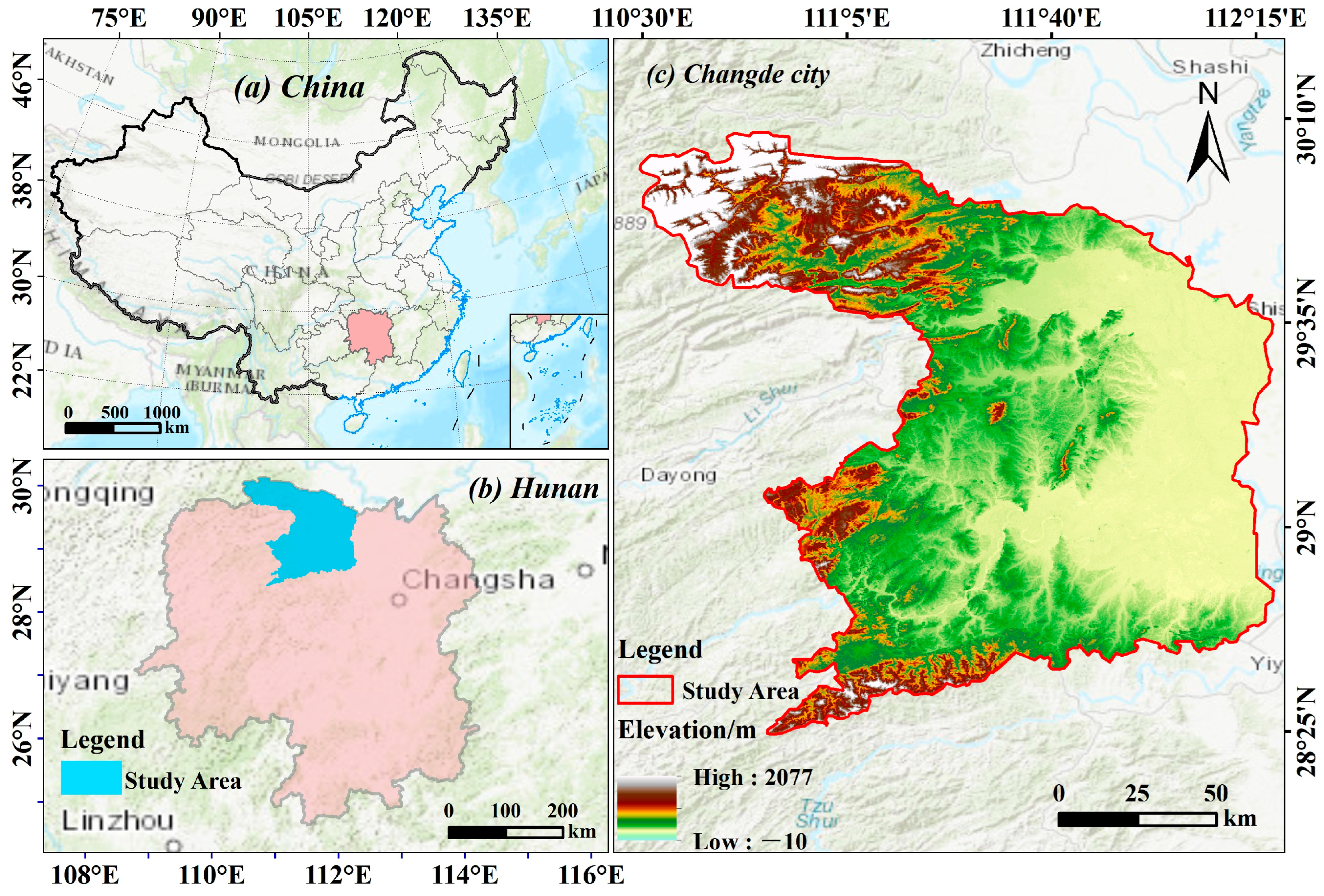

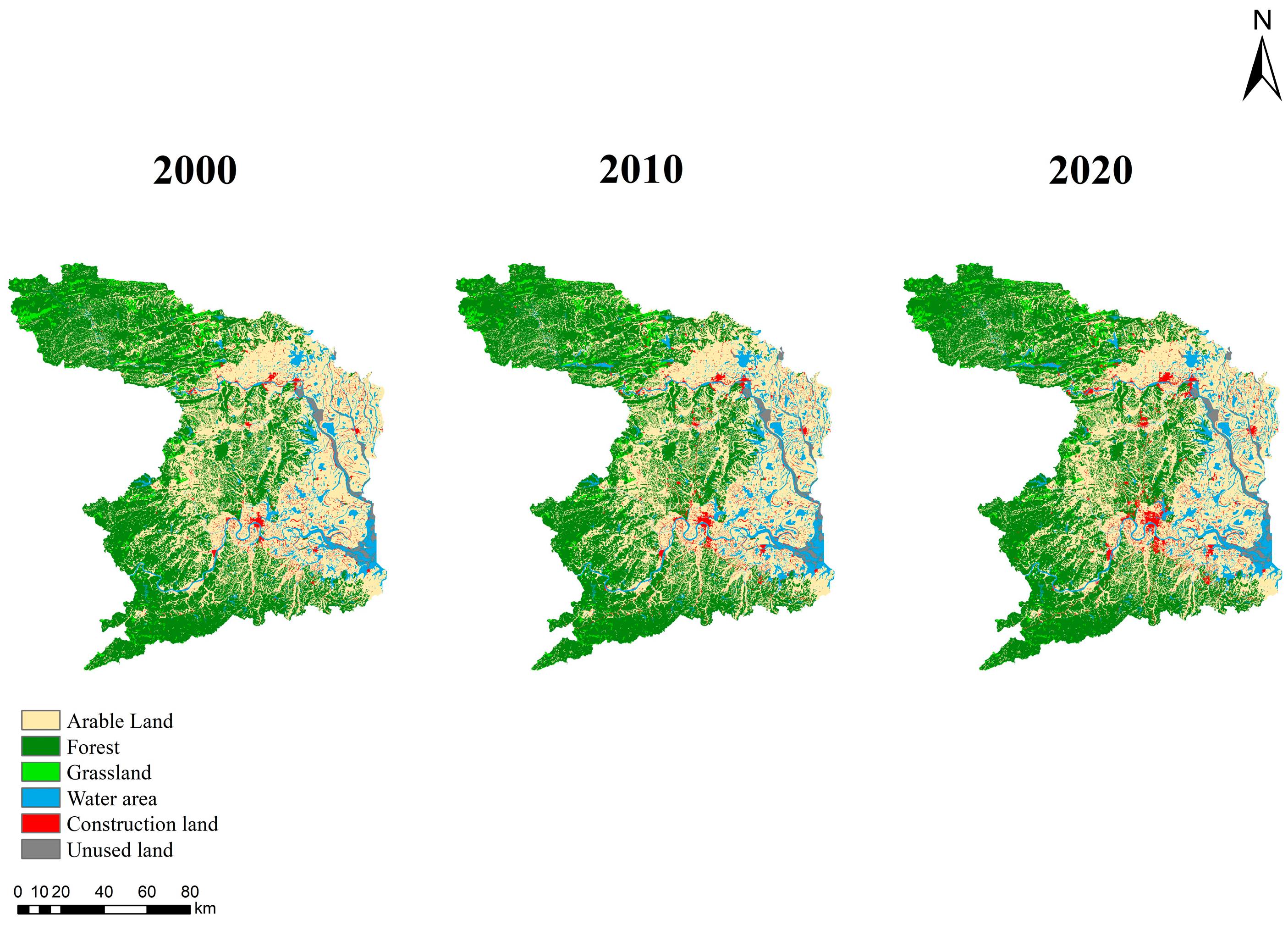
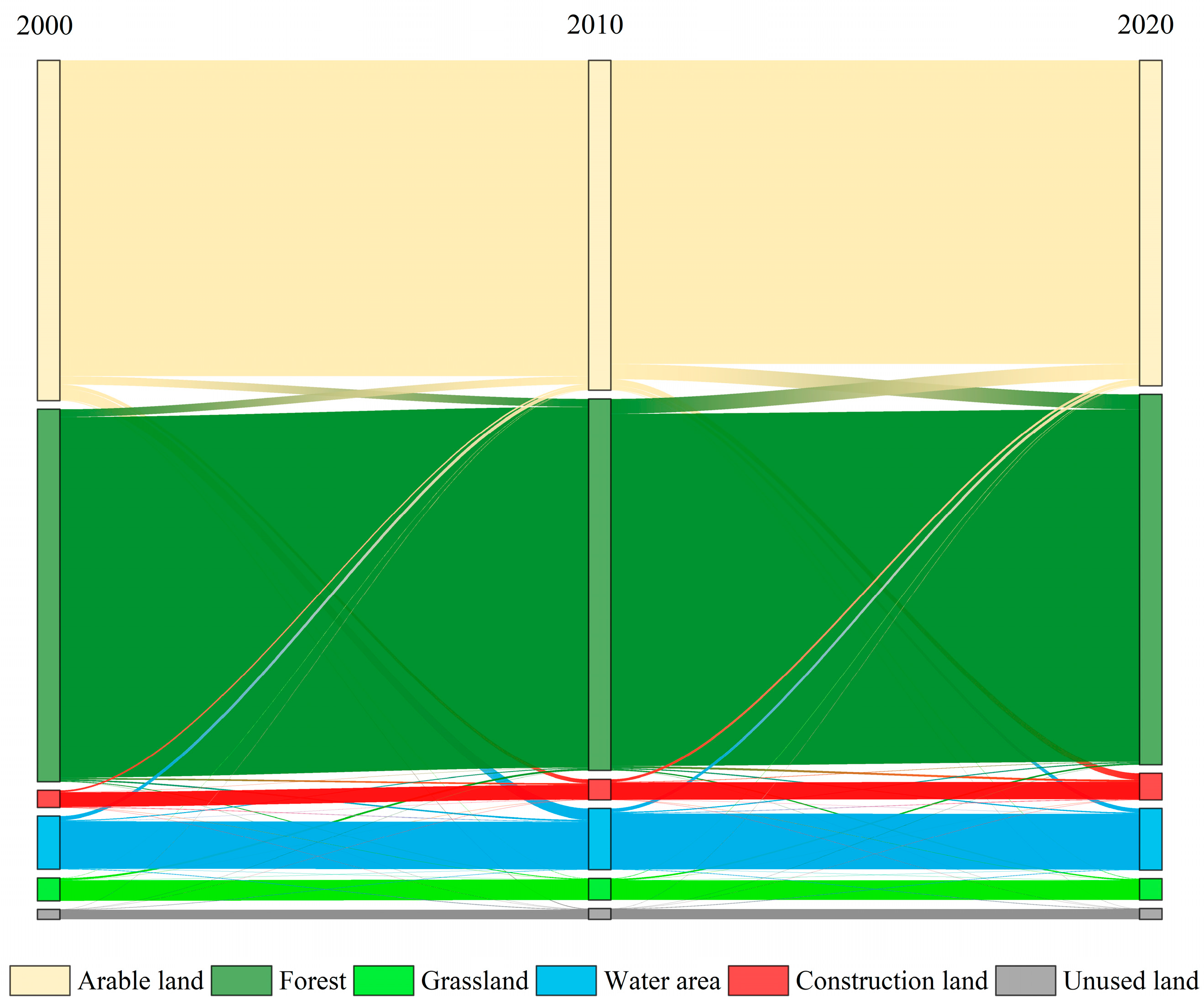
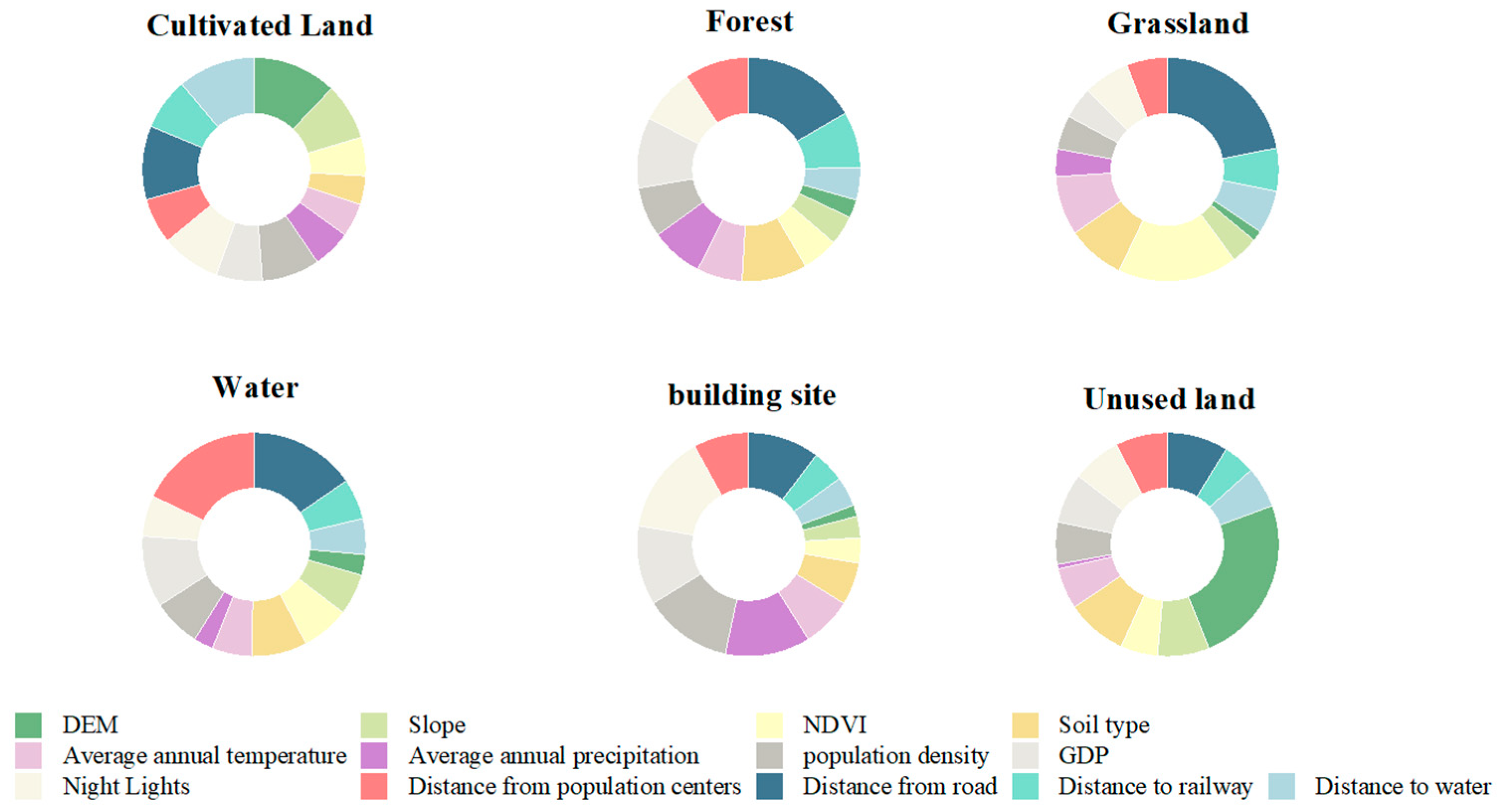




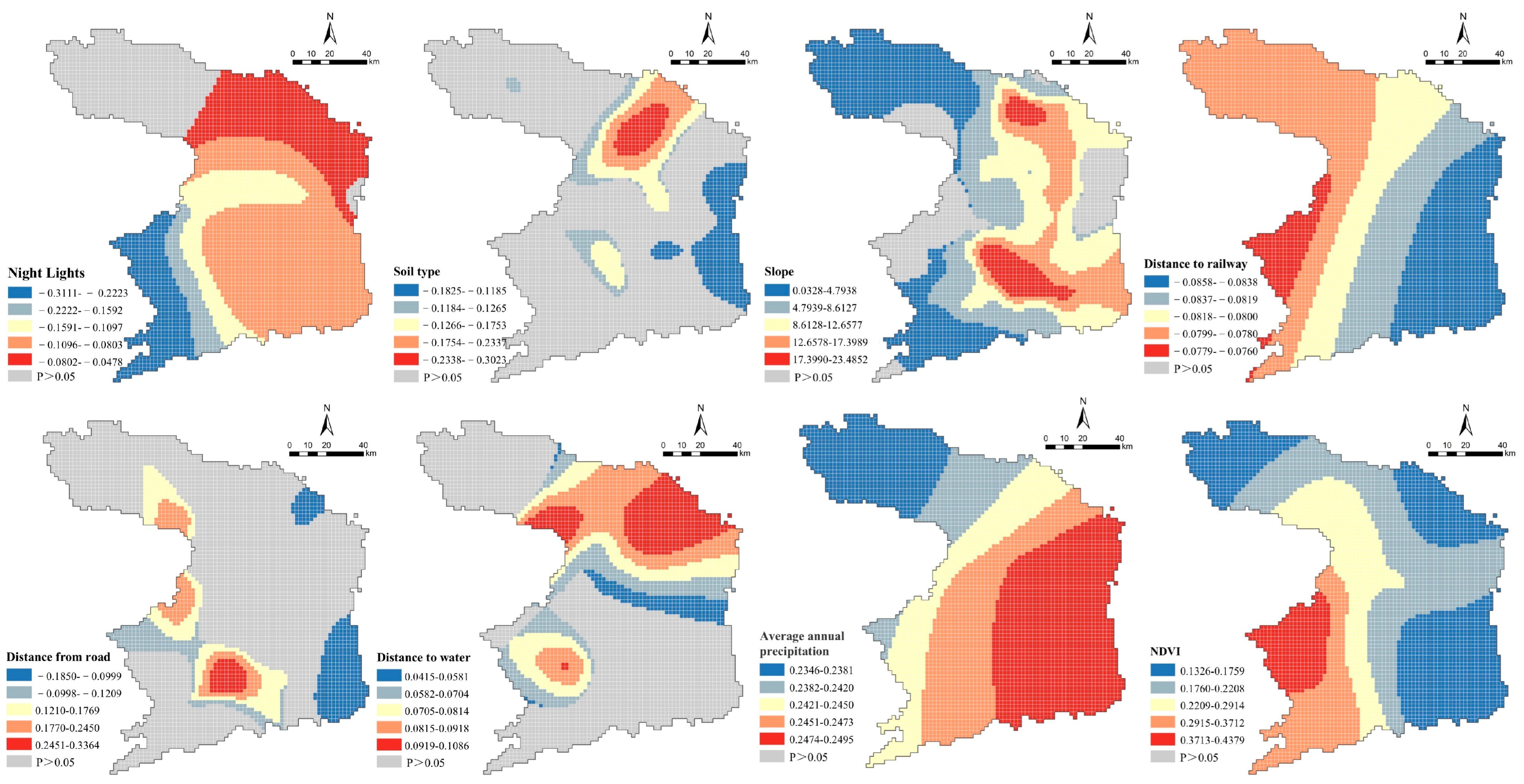
| Main Category | Data | Resolution | Source |
|---|---|---|---|
| Natural factor | DEM | 30 m | SRTM (https://earthexplorer.usgs.gov) (accessed on 6 May 2024) |
| Slope | 30 m | DEM data calculation generation | |
| NDVI | 1 km | Resource and Environmental Science Date Platform (http://www.resdc.cn/data) (accessed on 6 May 2024) | |
| Soil type | 1 km | Resource and Environmental Science Date Platform (http://www.resdc.cn/data) (accessed on 7 May 2024) | |
| Average annual temperature | 1 km | Resource and Environmental Science Date Platform (http://www.resdc.cn/data) (accessed on 6 May 2024) | |
| Average annual precipitation | 1 km | ||
| Socio-economic factors | Population density | 1 km | Resource and Environmental Science Date Platform (http://www.resdc.cn/data) (accessed on 6 May 2024) |
| GDP | 1 km | Resource and Environmental Science Date Platform (http://www.resdc.cn/data) (accessed on 6 May 2024) | |
| Night lights | 1 km | Resource and Environmental Science Date Platform (http://www.resdc.cn/data) (accessed on 7 May 2024) | |
| Accessibility factor | Distance from population centers | 30 m | National Geographic Information Resources Catalogue Service System (https://www.webmap.cn) (accessed on 8 May 2024) |
| Distance from road | 30 m | Open Street Map (https://www.openstrectmap.org) (accessed on 12 May 2024) | |
| Distance to railway | 30 m | ||
| Distance to water | 30 m |
| Land Use Type | Cabove | Cbelow | Csoil | Cdead |
|---|---|---|---|---|
| Arable land | 0.76 | 10.81 | 15.61 | 3.64 |
| Forest | 5.68 | 15.53 | 34.11 | 7.06 |
| Grassland | 4.73 | 11.59 | 14.39 | 4.08 |
| Water area | 0.34 | 0 | 11.23 | 0 |
| Construction land | 0.4 | 0 | 0 | 0 |
| Unused land | 0.48 | 1.23 | 1.43 | 1.13 |
| Land Use Type | Year | Area (km2) | Percentage (%) |
|---|---|---|---|
| Arable land | 2000 | 7568.05 | 41.69 |
| 2010 | 7336.32 | 40.41 | |
| 2020 | 7237.04 | 39.87 | |
| Forest | 2000 | 8282.18 | 45.62 |
| 2010 | 8268.25 | 45.55 | |
| 2020 | 8239.14 | 45.39 | |
| Grassland | 2000 | 503.52 | 2.77 |
| 2010 | 476.83 | 2.63 | |
| 2020 | 470.01 | 2.59 | |
| Water area | 2000 | 1182.95 | 6.52 |
| 2010 | 1362.56 | 7.51 | |
| 2020 | 1370.78 | 7.55 | |
| Construction land | 2000 | 382.78 | 2.11 |
| 2010 | 457.70 | 2.52 | |
| 2020 | 584.50 | 3.22 | |
| Unused land | 2000 | 233.25 | 1.28 |
| 2010 | 251.06 | 1.38 | |
| 2020 | 251.26 | 1.38 |
| 2020 | Arable Land | Forest | Grassland | Water Area | Construction Land | Unused Land | |
|---|---|---|---|---|---|---|---|
| 2000 | |||||||
| Arable land | 6831.01 | 259.06 | 10.25 | 270.46 | 181.92 | 15.34 | |
| Forest | 251.90 | 7899.51 | 22.33 | 38.12 | 69.94 | 0.38 | |
| Grassland | 8.34 | 51.99 | 436.06 | 2.34 | 4.79 | 0 | |
| Water area | 94.71 | 23.10 | 1.10 | 1035.49 | 12.87 | 15.68 | |
| Construction land | 49.21 | 5.36 | 0.26 | 11.80 | 314.88 | 1.27 | |
| Unused land | 1.88 | 0.11 | 0 | 12.56 | 0.10 | 218.59 | |
| Land Use Type | Area of 2020 (km2) | Scenarios | Area of 2030 (km2) | Rate of Change (%) |
|---|---|---|---|---|
| Arable land | 7237.04 | Natural development | 7160.71 | −1.05 |
| Arable land protection | 7293.09 | 0.77 | ||
| Ecological protection | 7053.18 | −2.54 | ||
| Forest | 8239.14 | Natural development | 8215.33 | −0.29 |
| Arable land protection | 8216.03 | −0.28 | ||
| Ecological protection | 8329.12 | 1.09 | ||
| Grassland | 470.01 | Natural development | 463.75 | −1.33 |
| Arable land protection | 459.51 | −2.23 | ||
| Ecological protection | 467.81 | −0.47 | ||
| Water area | 1370.78 | Natural development | 1378.08 | 0.53 |
| Arable land protection | 1341.65 | −2.12 | ||
| Ecological protection | 1387.24 | 1.20 | ||
| Construction land | 584.50 | Natural development | 689.1084 | 17.90 |
| Arable land protection | 591.62 | 1.22 | ||
| Ecological protection | 663.91 | 13.59 | ||
| Unused land | 251.26 | Natural development | 245.7477 | −2.19 |
| Arable land protection | 250.83 | −0.17 | ||
| Ecological protection | 251.46 | 0.08 |
| Land Use Type of 2000 | Land Use Type of 2020 | Transferred Area (km2) | Area of Change (km2) | Change in Carbon Stocks (×104 tons) | Total Change (×104 tons) |
|---|---|---|---|---|---|
| Arable land | Forest | 259.06 | −331.00 | 81.76 | −29.31 |
| Grassland | 10.25 | 0.41 | |||
| Water area | 270.46 | −52.06 | |||
| Construction land | 181.92 | −55.34 | |||
| Unused land | 15.34 | −4.07 | |||
| Forest | Arable land | 251.90 | −43.04 | −79.50 | −148.60 |
| Grassland | 22.33 | −6.16 | |||
| Water area | 38.12 | −19.37 | |||
| Construction land | 69.94 | −43.35 | |||
| Unused land | 0.38 | −0.22 | |||
| Grassland | Arable land | 8.34 | −33.52 | −0.33 | 11.83 |
| Forest | 51.99 | 14.35 | |||
| Water area | 2.34 | −0.54 | |||
| building site | 4.79 | −1.65 | |||
| Water area | Arable land | 94.71 | 187.83 | 18.23 | 27.64 |
| Forest | 23.10 | 11.74 | |||
| Grassland | 1.10 | 0.26 | |||
| Construction land | 12.87 | −1.44 | |||
| Unused land | 15.68 | −1.14 | |||
| Construction land | Arable land | 49.21 | 201.72 | 14.97 | 19.75 |
| Forest | 5.36 | 3.32 | |||
| Grassland | 0.26 | 0.09 | |||
| Water area | 11.80 | 1.32 | |||
| Unused land | 1.27 | 0.05 | |||
| Unused land | Arable land | 1.88 | 18.01 | 0.50 | 1.48 |
| Forest | 0.11 | 0.07 | |||
| Water area | 12.56 | 0.92 | |||
| Construction land | 0.10 | 0.00 |
| Land Use Type | Carbon Stocks in 2020 (×104 tons) | Rate of Change (%) | Scenarios | Carbon Stocks in 2030 (×104 tons) | Rate of Change (%) |
|---|---|---|---|---|---|
| Arable land | 2230.46 | 28.95 | Natural development | 2206.93 | 28.82 |
| Arable land protection | 2247.73 | 29.19 | |||
| Ecological protection | 2173.79 | 28.21 | |||
| Forest | 5139.57 | 66.70 | Natural development | 5124.72 | 66.92 |
| Arable land protection | 5125.16 | 66.55 | |||
| Ecological protection | 5195.70 | 67.42 | |||
| Grassland | 163.51 | 2.12 | Natural development | 161.34 | 2.10 |
| Arable land protection | 159.86 | 2.08 | |||
| Ecological protection | 162.75 | 2.11 | |||
| Water area | 158.60 | 2.06 | Natural development | 159.44 | 2.08 |
| Arable land protection | 155.23 | 2.02 | |||
| Ecological protection | 160.50 | 2.08 | |||
| Construction land | 2.34 | 0.03 | Natural development | 2.76 | 0.04 |
| Arable land protection | 2.37 | 0.03 | |||
| Ecological protection | 2.66 | 0.04 | |||
| Unused land | 10.73 | 0.14 | Natural development | 2.76 | 0.04 |
| Arable land protection | 10.71 | 0.13 | |||
| Ecological protection | 10.74 | 0.14 |
Disclaimer/Publisher’s Note: The statements, opinions and data contained in all publications are solely those of the individual author(s) and contributor(s) and not of MDPI and/or the editor(s). MDPI and/or the editor(s) disclaim responsibility for any injury to people or property resulting from any ideas, methods, instructions or products referred to in the content. |
© 2025 by the authors. Licensee MDPI, Basel, Switzerland. This article is an open access article distributed under the terms and conditions of the Creative Commons Attribution (CC BY) license (https://creativecommons.org/licenses/by/4.0/).
Share and Cite
Luo, Z.; Chen, C.; She, J.; Wang, Y.; Tong, W.; Guo, Z. Spatiotemporal Analysis, Predictive Modeling, and Driving Mechanism Investigation of Carbon Storage Dynamics in Changde City Under the Framework of LUCC. Sustainability 2025, 17, 1273. https://doi.org/10.3390/su17031273
Luo Z, Chen C, She J, Wang Y, Tong W, Guo Z. Spatiotemporal Analysis, Predictive Modeling, and Driving Mechanism Investigation of Carbon Storage Dynamics in Changde City Under the Framework of LUCC. Sustainability. 2025; 17(3):1273. https://doi.org/10.3390/su17031273
Chicago/Turabian StyleLuo, Ziyi, Caihong Chen, Jiyun She, Yamin Wang, Wenfu Tong, and Zexin Guo. 2025. "Spatiotemporal Analysis, Predictive Modeling, and Driving Mechanism Investigation of Carbon Storage Dynamics in Changde City Under the Framework of LUCC" Sustainability 17, no. 3: 1273. https://doi.org/10.3390/su17031273
APA StyleLuo, Z., Chen, C., She, J., Wang, Y., Tong, W., & Guo, Z. (2025). Spatiotemporal Analysis, Predictive Modeling, and Driving Mechanism Investigation of Carbon Storage Dynamics in Changde City Under the Framework of LUCC. Sustainability, 17(3), 1273. https://doi.org/10.3390/su17031273






